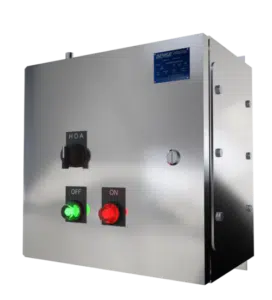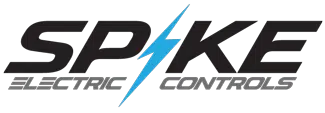 In the dynamic realm of industrial and commercial lighting, it’s paramount to ensure that electrical components can endure time, environmental challenges, and routine wear and tear. Introducing the Stainless Steel NEMA 4X Rated Lighting Contactors. Recognizing the importance of these contactors, today we will explore their attributes and advantages and discuss why they have become a cornerstone of modern electrical infrastructure. Our NEMA 4X Lighting Contactors are produced in an ISO 9001 Quality-Controlled Facility and are UL 508A listed. The UL 50E NEMA 4X Enclosure can be outfitted with a myriad of accessories, including HOAs, external LED indication lights, local or remote push buttons, photocells, and any other custom industry requests. These are consistently available in our quick ship program; simply reach out to your local sales representative for more details!
In the dynamic realm of industrial and commercial lighting, it’s paramount to ensure that electrical components can endure time, environmental challenges, and routine wear and tear. Introducing the Stainless Steel NEMA 4X Rated Lighting Contactors. Recognizing the importance of these contactors, today we will explore their attributes and advantages and discuss why they have become a cornerstone of modern electrical infrastructure. Our NEMA 4X Lighting Contactors are produced in an ISO 9001 Quality-Controlled Facility and are UL 508A listed. The UL 50E NEMA 4X Enclosure can be outfitted with a myriad of accessories, including HOAs, external LED indication lights, local or remote push buttons, photocells, and any other custom industry requests. These are consistently available in our quick ship program; simply reach out to your local sales representative for more details!
What are Lighting Contactors?
Before we dive into the specifics of the NEMA 4X-rated variant, it’s essential to understand the basic premise behind lighting contactors. These are electrically controlled switches, typically relay type, used for switching a large quantity of electrical power through its contacts. They’re often integrated into lighting systems for commercial, industrial, and outdoor lighting applications. Lighting contactors play a pivotal role in the control of electric circuits. Whether you’re a new sales rep trying to grasp the basics or an electrical engineer deep in the intricacies of system design, understanding these devices is crucial. Let’s journey from the foundational concepts to the more nuanced details of lighting contactors.
- Definition: “At its most basic level, a lighting contactor is an electrically operated switch used to control a lighting circuit. Unlike the typical light switch you might find at home, which manually controls one or a few light fixtures, a lighting contactor can manage multiple, often large-scale, lighting circuits simultaneously. Have you ever noticed how a park or parking lot lights up automatically at dusk? This is achieved when a photocell is wired to a lighting contactor. When a certain light level ceases to hit the photocell, it signals the lighting contactor to turn on or “close contacts.” By “close contacts,” we mean that the contactor, much like a light switch in the off position, has its internal copper contacts “close” or come together. This allows the flow of electricity to pass through to the light fixtures.”
2. How They Work:
- Principle: Lighting contactors use a low-power input, known as the control circuit, to control a higher-power circuit. When the control circuit is activated, usually by a simple switch or a relay, it energizes a coil inside the contactor, pulling in a set of electrical contacts that allow power to flow to the lights.
- Components:
- Coil: This is the magnetizing component that gets activated when power is applied.
- Contacts: These act like the gatekeepers. When the coil is energized, the contacts close, allowing current to pass through the higher-power circuit.
- Auxiliary Contacts: These are often used for secondary controls and feedback systems.
Delving into the Coil of a Lighting Contactor: Understanding the Heartbeat
A lighting contactor, as previously explained, acts as a powerful electrically operated switch. Yet, if you ever decide to unravel its mystery, you’ll marvel at a component called the “coil.” This coil, in many ways, is the heartbeat of a lighting contactor. Let’s delve into understanding its function and how the various voltage ratings play a part.
The Coil – What is it?
The coil in a lighting contactor is an electromagnet. When energized by an electric current, it generates a magnetic field. This magnetic field is what pulls the contactor’s contacts together, thereby allowing the larger current to flow through the circuit and light up your fixtures.
How it Works:
- Activation: When a control signal (low power) is applied to the coil, it gets energized. This means electric current flows through the coil’s windings, creating a magnetic field.
- Magnetic Attraction: This magnetic field attracts a movable armature (often a piece of metal) inside the contactor. As this armature moves, it causes the main power contacts to close.
- Deactivation: When the control signal is turned off, the coil de-energizes. The magnetic field dissipates, the armature returns to its original position (often aided by a spring), and the contacts open, breaking the circuit.
3. Significance of Coil Voltage:
The voltage rating of a coil is critical. This rating determines what voltage is required to reliably energize the coil and, thus, operate the contactor. Using the wrong voltage can result in weak magnetic fields (leading to unreliable operation) or over-energization (which can burn out the coil).
For those perusing our selection of lighting contactors, we offer coils in the following voltage ratings:
- A. 120V: Common for many residential and commercial applications in North America.
- B. 208V*: Often seen in commercial settings where three-phase power is utilized.
- C. 240V*: Typical in both residential and commercial settings in many parts of the world.
- D. 480V*: This is a standard voltage for industrial applications in North America.
- E. 600V*: Less common but is available for specialized high-voltage applications.
(Note: An asterisk denotes that a specific voltage level might not be standard and could require special order or be subject to availability.)
Why Coil Voltage Matters:
Using a coil with the right voltage rating ensures:
- Reliable Operation: The coil will produce a consistent magnetic field strong enough to operate the contactor.
- Safety: Prevents potential hazards like coil overheating or fire.
- Longevity: Ensures the coil isn’t over or under-stressed, which can lead to premature failures.
The coil, though often overlooked, plays a pivotal role in the proper functioning of a lighting contactor. When considering a contactor for your needs, always ensure that the coil’s voltage rating aligns with the control circuit’s available voltage. By doing so, you’re ensuring the safety, reliability, and efficiency of your lighting system.
3. Varieties and Classification:
- Pole Number: Contactors can be single-pole (handling one circuit) or multiple poles (handling several circuits).
- Actuation Type: There are mechanically held and electrically held contactors. The former stays closed or open even after the coil is de-energized, while the latter requires continuous power to remain in its position.
- Control Source: Depending on the power source, there are AC and DC coil contactors.
4. Key Features and Importance:
- Versatility: They can handle various types of lights, from fluorescent to LED, making them versatile across different applications.
- Safety: By centralizing control, contactors can safely manage high power loads, preventing circuit overloads and potential fires.
- Remote Control: Especially in larger settings like stadiums or commercial buildings, being able to control lights from a central location or via automated systems is essential.
5. Advanced Considerations:
- Coil Ratings: Engineers need to ensure the coil’s voltage rating matches the control circuit’s available voltage.
- Contact Ratings: The contact rating should be appropriate for the current and voltage of the lighting system it controls.
- Environmental Conditions: For environments exposed to moisture, dust, or corrosive elements, choosing a contactor with the right NEMA or IP rating is crucial.
- Harmonic Distortion: Some types of lights, especially certain LEDs and fluorescents, can introduce harmonics into the electrical system. Engineers need to be aware of this when designing systems and may need to include filters or choose specific contactor types to manage these harmonics.
Think of a lighting contactor as the behind-the-scenes director of a lighting show. It takes the cue (the low-power input) and executes the scene (turning on or off the lights).
For the electrical engineer: Beyond the basic operation, the intricate considerations of coil and contact ratings, the type of lights being controlled, and the environment’s conditions play a crucial role in selecting and designing lighting contactors. Proper knowledge ensures the efficiency, safety, and longevity of the entire lighting system.
Why the Need for a Stainless Steel Nema 4X Rating?
The NEMA 4X rating signifies a particular kind of protection. Devices with this rating are designed to be water and dust-tight. The addition of stainless steel not only enhances the device’s resistance to corrosion, chemicals, and other external factors but also makes it suitable for places like food processing plants, where sanitation and cleanliness are paramount.
Key Attributes and Benefits:
- Robustness and Durability: Made from stainless steel, these contactors are resistant to rust, ensuring a longer lifespan and reduced maintenance needs.
- Definition: The NEMA 4X rating is provided by the National Electrical Manufacturers Association to denote enclosures primarily designed for outdoor or indoor use.
- Corrosion Resistance: Stainless steel construction provides excellent corrosion resistance, ensuring longevity in harsh environments.
- Protection from Water: NEMA 4X enclosures are watertight, ensuring protection against water sprays, splashing water, and hose-directed water.
- Dust and Particle Defense: These enclosures are designed to prevent the ingress of dust, ensuring equipment remains clean and functional.
- Ice Formation: NEMA 4X enclosures offer protection against the harmful effects of ice formation on the exterior.
- Extended Lifespan: The use of stainless steel not only ensures corrosion resistance but also increases the overall lifespan of the enclosure.
- Applications: Commonly used in food and beverage industries, marine environments, wastewater facilities, and pharmaceutical sectors due to their resilient properties.
- UV Resistance: Stainless steel NEMA 4X enclosures resist the damaging effects of prolonged UV exposure, which can degrade other materials over time.
- Temperature Tolerance: These enclosures can withstand a wide range of temperatures, making them suitable for both hot and cold environments.
- Security: NEMA 4X enclosures are often equipped with secure locking mechanisms to prevent unauthorized access.
- Hygiene: Their non-porous surface makes them ideal for industries where hygiene and easy cleaning are paramount.
- Robust Construction: Built to withstand physical impact, ensuring the safety of the equipment housed inside.
- Versatility: They can house a wide range of electrical equipment, from switches and sockets to complex control systems.
- Cost-Effective: Despite the initial investment, their durability, reduced maintenance needs, and longer lifespan can result in overall cost savings in the long run.
- Environmental Considerations: Their design ensures minimal environmental impact, as they prevent any leakage or seepage of contaminants from the enclosed equipment into the surrounding environment.
Application and Integration:
These Stainless Steel NEMA 4X Rated Lighting Contactors are designed for both industrial and commercial lighting purposes. The link provided takes you to Spike Electric, a reliable purveyor of these contactors. Spike Electric’s SN4XLC series is a testament to quality and durability, ensuring the best for its consumers.
The Verdict:
For any industry or business where resilience, longevity, and performance matter, investing in Stainless Steel NEMA 4X Rated Lighting Contactors is a no-brainer. They not only promise efficiency but also ensure the safety of the overall system, making them a wise choice for those aiming for uninterrupted operations and reduced downtime.
In an ever-evolving world where industries demand more resilience and reliability, these contactors, such as those offered by Spike Electric, set the gold standard. The fusion of cutting-edge design with practical needs makes them an indispensable tool in the modern electrical landscape.
Remember, when choosing electrical components, quality should never be compromised. And with Stainless Steel NEMA 4X Rated Lighting Contactors, you get the assurance of performance wrapped in unbeatable durability.
Where to buy a Stainless Steel NEMA 4x Lighting Contactor?
SN4XLC Stainless Steel Lighting Contactors
The SN4XLC stainless steel lighting contactors are the perfect solution for your industrial and commercial lighting needs. They are designed to withstand the harshest environments and conditions, and they offer a wide range of features and benefits, including:
- Variable lighting control: The SN4XLC contactors allow you to control your lighting in a variety of ways, including manual on/off, automatic settings, and photocell control.
- Maximum energy conservation: The photocell option on the SN4XLC contactors allows you to maximize the utilization of sunlight, which can help you save energy and money.
- Modular design: The SN4XLC contactors have a modular design that allows you to add future power poles as needed.
- Superior performance: The lighting contacts on the SN4XLC contactors are electrically held for superior performance.
- Global certification: The SN4XLC contactors are globally certified to meet the highest safety standards.
Written by: Cole Attaway
Cole Attaway is the founder and CEO of Spike Electric Controls. Spike’s mission is to improve the accessibility and delivery of industrial electrical gear for clients nationwide. Spike solutions result in reduced unplanned downtime, less overtime, and greater operational efficiencies.


